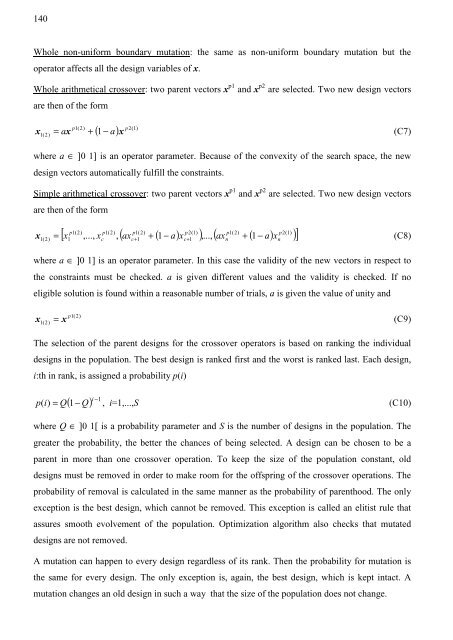Design and Voltage Supply of High-Speed Induction - Aaltodoc
Design and Voltage Supply of High-Speed Induction - Aaltodoc
Design and Voltage Supply of High-Speed Induction - Aaltodoc
You also want an ePaper? Increase the reach of your titles
YUMPU automatically turns print PDFs into web optimized ePapers that Google loves.
140<br />
Whole non-uniform boundary mutation: the same as non-uniform boundary mutation but the<br />
operator affects all the design variables <strong>of</strong> x.<br />
Whole arithmetical crossover: two parent vectors x p1 <strong>and</strong> x p2 are selected. Two new design vectors<br />
are then <strong>of</strong> the form<br />
x −<br />
p2(<br />
1)<br />
( 1 a)<br />
p1(<br />
2)<br />
1(<br />
2)<br />
= ax + x<br />
(C7)<br />
where a ∈ ]0 1] is an operator parameter. Because <strong>of</strong> the convexity <strong>of</strong> the search space, the new<br />
design vectors automatically fulfill the constraints.<br />
Simple arithmetical crossover: two parent vectors x p1 <strong>and</strong> x p2 are selected. Two new design vectors<br />
are then <strong>of</strong> the form<br />
p1(<br />
2)<br />
p1(<br />
2)<br />
p1(<br />
2)<br />
p2(<br />
1)<br />
p1(<br />
2)<br />
[ x ,..., x , ( ax + ( 1 − a)<br />
x ) , ..., ax + ( 1 − a)<br />
1(<br />
2)<br />
= 1<br />
c<br />
c+<br />
1<br />
c+<br />
1<br />
p2(<br />
1)<br />
( x )]<br />
x (C8)<br />
where a ∈ ]0 1] is an operator parameter. In this case the validity <strong>of</strong> the new vectors in respect to<br />
the constraints must be checked. a is given different values <strong>and</strong> the validity is checked. If no<br />
eligible solution is found within a reasonable number <strong>of</strong> trials, a is given the value <strong>of</strong> unity <strong>and</strong><br />
p1(<br />
2)<br />
x 1(<br />
2)<br />
= x<br />
(C9)<br />
The selection <strong>of</strong> the parent designs for the crossover operators is based on ranking the individual<br />
designs in the population. The best design is ranked first <strong>and</strong> the worst is ranked last. Each design,<br />
i:th in rank, is assigned a probability p(i)<br />
( ) 1 i −<br />
1−<br />
Q<br />
p ( i)<br />
= Q , i=1,...,S (C10)<br />
where Q ∈ ]0 1[ is a probability parameter <strong>and</strong> S is the number <strong>of</strong> designs in the population. The<br />
greater the probability, the better the chances <strong>of</strong> being selected. A design can be chosen to be a<br />
parent in more than one crossover operation. To keep the size <strong>of</strong> the population constant, old<br />
designs must be removed in order to make room for the <strong>of</strong>fspring <strong>of</strong> the crossover operations. The<br />
probability <strong>of</strong> removal is calculated in the same manner as the probability <strong>of</strong> parenthood. The only<br />
exception is the best design, which cannot be removed. This exception is called an elitist rule that<br />
assures smooth evolvement <strong>of</strong> the population. Optimization algorithm also checks that mutated<br />
designs are not removed.<br />
A mutation can happen to every design regardless <strong>of</strong> its rank. Then the probability for mutation is<br />
the same for every design. The only exception is, again, the best design, which is kept intact. A<br />
mutation changes an old design in such a way that the size <strong>of</strong> the population does not change. v<br />
n<br />
n
















